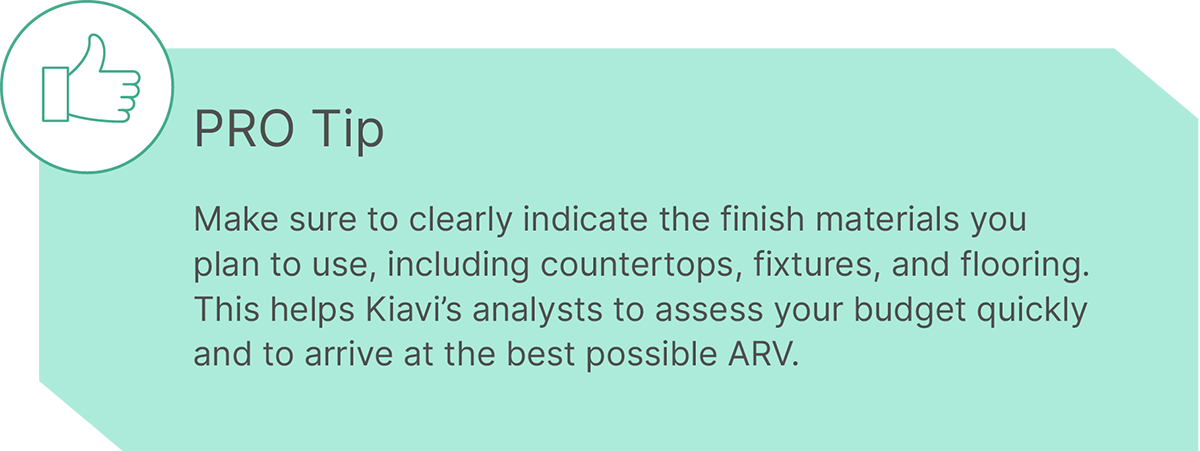
The Ins and Outs of Your Scope of Work
A Scope of Work (SOW) is a detailed outline of all planned construction and renovations of a project. A detailed SOW is essential for nearly every real estate investment strategy and requirement for funding with most lenders. Read on to learn more about the importance of creating a detailed SOW, its benefits to your projects, and its implications for financing. At Kiavi, an SOW is required after submitting a bridge loan application. For information on Kiavi's SOW requirements, visit our guide: Working with Kiavi: How to Submit a Scope of Work.
Why is an SOW so important in fix and flip projects?
A professional SOW often comes in spreadsheet form, with different sections dedicated to the various portions of your rehab or construction plan, with the ultimate costs to flip a house being summed together. If done correctly, the SOW will outline every single detail of an upcoming project and the materials to be used. Your SOW has many purposes:
- It helps you and your lender accurately estimate the After Repair Value (ARV) of the property
- It supports expectation alignment with your lender or any co-investors
- It's a guide for your contractors to help keep the project on time and on budget
- It helps you manage and document the various steps of your construction project
A professional SOW holds your contractors and subcontractors accountable throughout each project. If they see you as an organized and detailed project manager, they are more likely to also remain organized and on task. A detailed SOW also allows you to stay efficient, thus improving the likelihood that the project will be completed on time and within your set budget.
Having an accurate SOW is critical in determining if your target ARV is achievable or simply a dream – a clear acumen of the property's post-rehab condition is necessary for deciding its post-rehab value. Not only does an SOW help you better estimate your ARV – but it also allows your lender to estimate value.
The importance of an SOW in financing
We've illustrated some important benefits of creating a detailed SOW for your real estate investment projects, but SOWs have another critical role to play for your lending partners. The SOW provides your lender the confidence in your vision and your ability to execute it. Most importantly, it allows your lender to complete their financial underwriting.
After closing, the SOW is critical in forming the basis for future capital infusions through draws. Lenders like Kiavi fund rehab costs using a draw process in which the loan is broken up into pieces referred to as "draws," which are released to you, the borrower, as reimbursements after the work is completed. The first draw is released for the purchase of the property. Additional construction draws are released as the lender confirms work is completed according to the SOW, allowing you to fund subsequent portions of the project.
Without creating a thoughtful SOW upfront, investors can become confused when a lender does not approve a draw for work not part of the original approved plan. If the lender is unwilling to approve a related change order, it can create a problematic working capital shortfall risk that could have been avoided.
Components of a scope of work
Your SOW should be very specific and thorough. Broadly, it should include what work is being done, who will be doing the work, the timeline for completion, and the associated estimated costs. The following components should all be included in a scope of work:
Project overview: A detailed description of the construction project's goals, the work that will be done, and deliverables. It should include insight into the quality of materials, room or square foot additions, room conversions, redesigns, and any other future work on the fix and flip. Most investors split their SOW into interior and exterior. They then split the interior into various rooms and the exterior into the front of the house, the back of the house, and landscaping.
Management team: List who will be managing the project and their contact information. This will typically be the general contractor and/or contractor team. For contractors, list their licenses and license numbers.
Budget & Costs: Detailed breakdown of how much you plan to spend for each project step. Be thorough and specific — go room by room and detail what you plan to work on and how much it will cost. The more information you put in, the easier it is to stick with your house-flipping financing. Project Schedule: Explain the order in which different tasks of the construction project will be undertaken and how long each task will take. Remember, rehab projects typically take longer than expected, and things may not go 100% according to plan, so give yourself some wiggle room. Acceptance: Clearly outline all inspection requirements, testing and validation processes, permits to be obtained, approval process, and borrower sign-offs.

Project Schedule: Explain the order in which different tasks of the construction project will be undertaken and how long each task will take. Remember, rehab projects typically take longer than expected, and things may not go 100% according to plan, so give yourself some wiggle room.
Acceptance: Clearly outline all inspection requirements, testing and validation processes, permits to be obtained, approval process, and borrower sign-offs.
A well-thought-out SOW defines each person's responsibility, helps avoid unnecessary conflicts, minimizes risks, and improves overall investment returns.
Working with Kiavi: Submitting your scope of work
At Kiavi, we help our customers maintain a detailed SOW for each project with a digital scope of work template and process integrated directly into the online loan experience through your borrower dashboard. This allows you to check on the project status and review the budget anytime, anywhere online. To learn more, check out Kiavi's How to Submit a Scope of Work Guide.
Do you have a deal in mind? Reach out to us – our team would be happy to discuss your project (or one you’re considering), go over the numbers, answer any questions and lend our perspective.